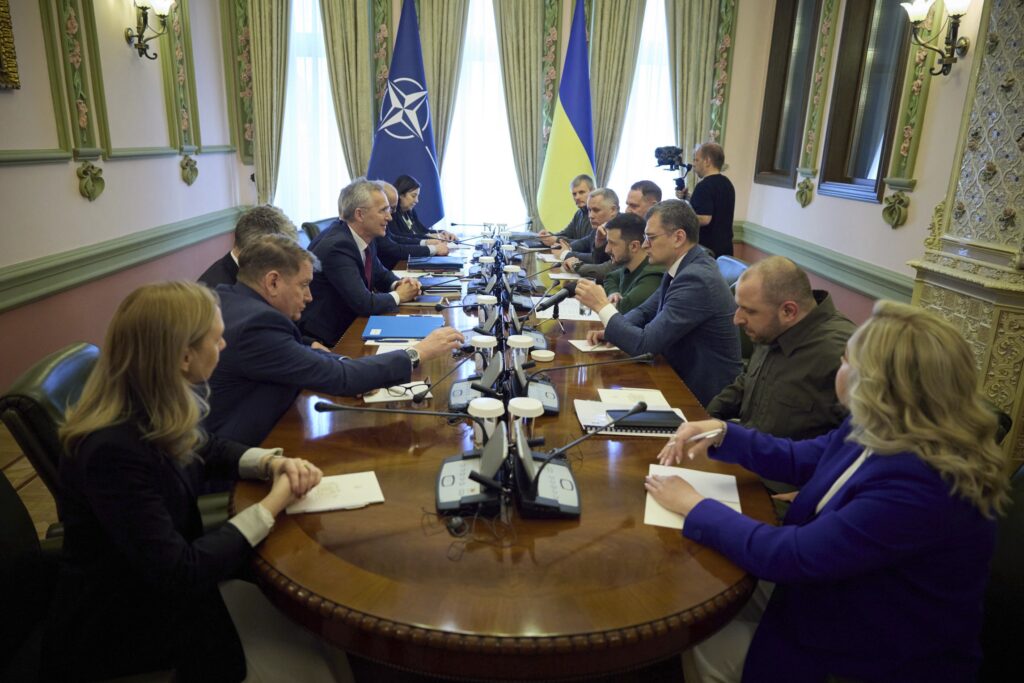Western powers will put Ukraine on “an irreversible path towards NATO membership,” according to the civilian chief of the alliance, who visited Ukrainian President Volodymyr Zelensky amid admitted Western shortcomings even in delivering air defense systems to fend off Russia’s attacks.
“The work we are undertaking now puts you on an irreversible path towards NATO membership,” NATO Secretary-General Jens Stoltenberg said in Kyiv. “So that when the time is right, Ukraine can become a NATO member straightaway.”
That eventuality remains remote (despite a surge in rhetorical commitments to Ukraine’s security and future prospects for NATO membership) because the United States and other key Western powers remain as hesitant to extend a formal invitation as they were before Russia attempted to conquer the country. That diplomatic reality persisted into the third year of the full-scale war, with Western powers struggling to balance the need to show support for Ukraine with their own determination to avoid policy courses deemed too confrontational toward Russia.
“We were not prepared last summer to extend a proper invitation to Ukraine for full-fledged membership, and I am not expecting the Alliance to do that this summer,” Ambassador Julianne Smith, the top U.S. diplomat at NATO headquarters, said Monday during an Atlantic Council event. “What I am expecting allies to do is to construct a bridge to membership, by offering Ukraine a deliverable that will enable them to become even closer to this alliance.”

Stoltenberg offered a glimpse of that “bridge” during his appearance in Kyiv by putting an emphasis on the development of the Ukrainian military in line with the “NATO standards” that allow the allied militaries to work together.
“In the meantime, we should ensure that Ukraine becomes as interoperable as possible, that Ukraine is fully up to all NATO standards, so when the political conditions are in place, that Ukraine can become a member straight away,” he said. “Therefore, I also believe that what we now do when it comes to military support is partly about ensuring the urgent needs for Ukraine, and we discussed how we can step up more military support for Ukraine. But it’s also about how to ensure that we deliver the capabilities and help to build the Ukrainian future force that enables Ukraine to become a member of this alliance.”
President Joe Biden and German Chancellor Olaf Scholz are perceived as the major opponents inside NATO of extending a formal invitation to Ukraine to join the alliance eventually.
“Enlargement, in the sense of inviting Ukraine, at least for accession talks to begin, is nothing that Biden wants, is nothing that Scholz wants,” former NATO strategist Stefanie Babst told the Washington Examiner. “The rest I’d say of the gang at NATO is a bit all over the place, but there are a number of countries that would clearly appreciate if the summit deliverable would be the beginning of accession talks with Ukraine. But, clearly, Biden is not up for it.”
That disagreement erupted into a controversy at the 2023 NATO Leader Summit in Vilnius, Lithuania. While acknowledging that Ukraine cannot join the alliance “when the war is going on,” as Estonian Prime Minister Kaja Kallas said, many allies pushed for the security bloc to commit to an eventual invitation on the theory that this diplomatic gesture would press Russian President Vladimir Putin to adjust his expectations about Ukraine’s future. Instead, the allies could only agree on a promise “to extend an invitation to Ukraine to join the Alliance when Allies agree and conditions are met” — an ambiguous statement that disappointed Russia hawks across the trans-Atlantic community.
“I’m working hard to ensure that Ukraine will become a member of this alliance,” Stoltenberg said. “To have that decision, we need all allies to agree, we need consensus, we need not the majority but actually 32 allies to agree. And I don’t expect that we will have that agreement by the summit in July. But I really hope that we can demonstrate that we are moving Ukraine closer to membership and that they will arrive as soon as possible for us to have Ukraine as a full member.”
The gap between Western promises and actual support has widened over the last several months, as a political impasse in Washington, D.C., led to a protracted lapse in the delivery of U.S. military equipment for beleaguered Ukrainian forces. That logjam broke last week when Biden signed a new supplemental defense spending package into law, but Zelensky noted that the need for “timely support of the armed forces” remains unmet.
“I am yet to see significant positive developments. Deliveries have started, but this process needs to be sped up,” Zelensky said. “One thing is to have funds. Well, that’s important, and once again, we sincerely appreciate that decision, but it is as important to see what we can get with these funds. I’m not even talking about the issue of how these weapons can be used.”
CLICK HERE TO READ MORE FROM THE WASHINGTON EXAMINER
That was an apparent reference to a pair of distinct but related debates between Ukrainian and Western officials centered, first, on the types of weaponry that Ukrainian forces will be permitted to obtain and, secondly, on restrictions that Western officials have imposed on the usage of those weapons (most prominently, whether they can be used to strike targets inside of Russia, for instance).
“NATO allies have not delivered what they promised. The United States spent months not agreeing a package for Ukraine, and European allies have not delivered the amount of ammunition they promised,” Stoltenberg acknowledged before touting the supplemental U.S. aid package and new air defense and ammunition from other Western countries. “But again, announcements are not enough. We need to see the delivery of the weapons. … This war is not a kind of theoretical thing. If something’s going on 24/7, and when we are not delivering as we should, then Ukrainians are paying the price.”
